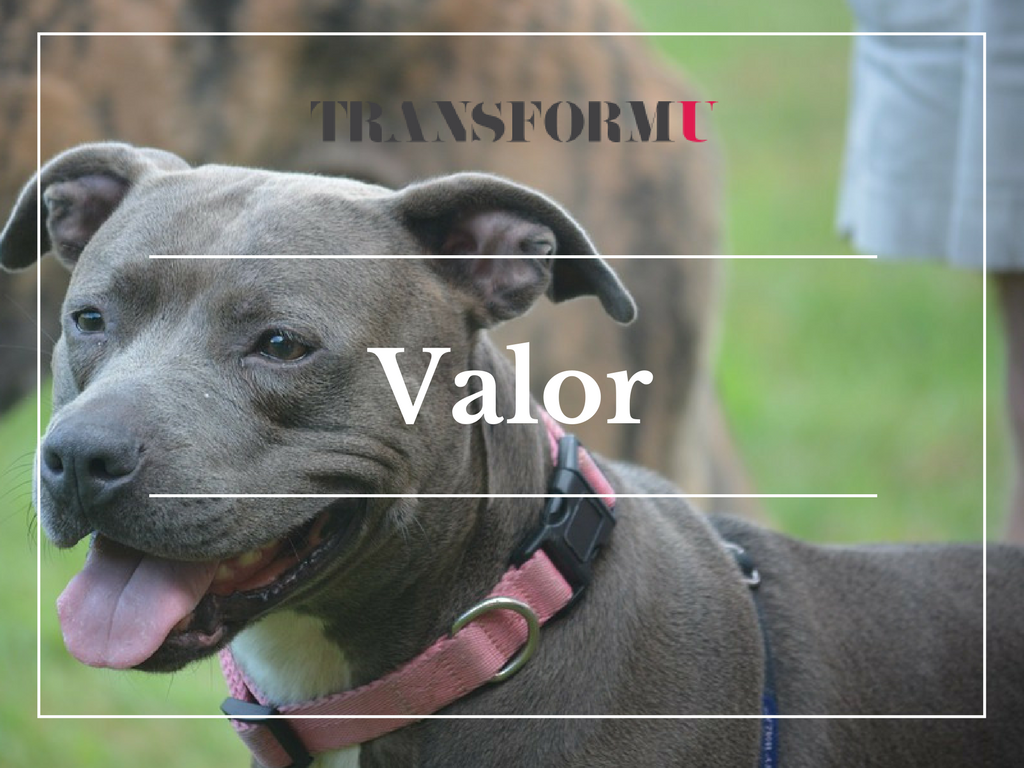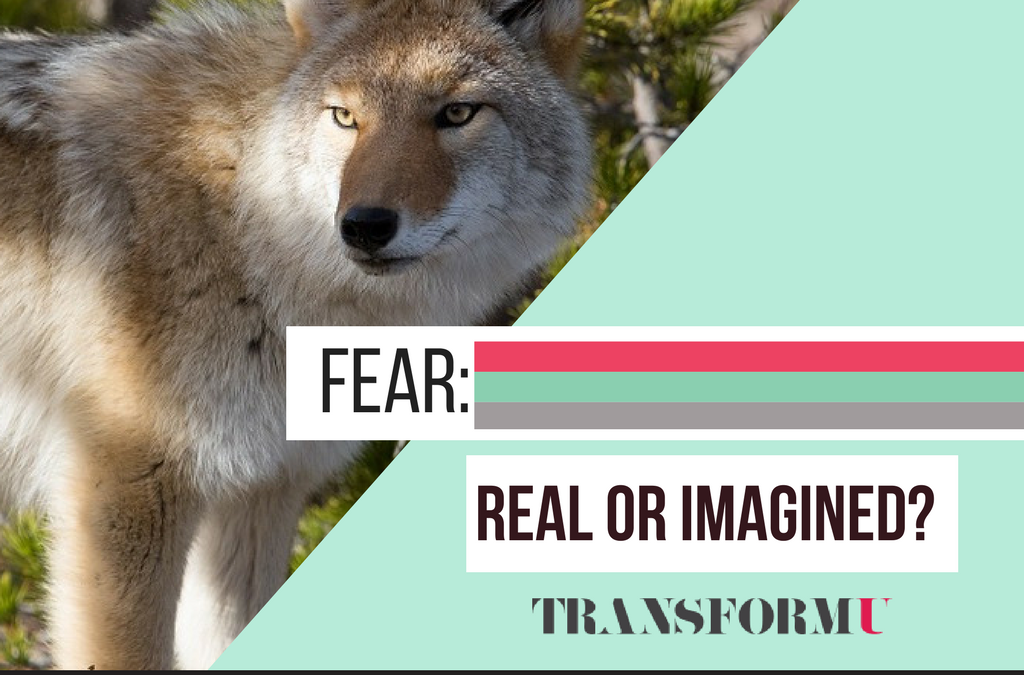It had been a very long day and I got home later than usual. I was going to skip dinner and just blend a protein drink so I could sit down and decompress from my day. I was greeted at the door by my dog Valor. Unfortunately she had been inside way longer than what she’s used to and was ready for the highlight of her day – a walk.
I said to myself, “I’ll let her outside and forego the evening walk, I’m tired and hungry.” I don’t know what your emotional vulnerabilities are, but I’m a sucker for three things in life: white chocolate chip macadamia nut cookies, sad puppy dog faces, and babies. Since the cookies and babies were not in the picture, that left the sad puppy dog face to tug on my emotions.
“Fine,” I said to Valor, “Let’s go for a walk.” Grabbing the leash, flashlight, and my cell phone off we went. We were almost home when Valor stopped abruptly. With the hair on her back standing on end, she turned her head to the left, firmly planted on all four legs and glared into the darkness. If I had hair on my spine, it too would have stood on end because when I pointed the flashlight towards the direction she was staring, I saw piercing, greenish-yellow eyes staring back at us.
My intuition told me that it was a momma coyote with one of her pups. The pack of coyotes had been the topic of conversation on my neighborhood app for the past couple of days. I had the sense to know that I needed to remain calm, move slowly but think quickly. What would my next move be? How could I protect Val and get us home safely?
Developing a Healthy Relationship with Fear
You certainly don’t need to have lived very long to know that fear is universal and all pervasive; the effects of which can be paralyzing. I had a very unhealthy relationship with fear for so many years. I suffered from deep rooted fear and anxiety most of my life so I understand this subject only too well. I had to walk through the dark night of my soul and face my old time nemesis in order to overcome it. I wish I had known then what I know now.
I’d like to share with you what I learned about fear and anxiety so as to shed some light on this once dreaded enemy of mine and perhaps help you develop a healthy relationship with fear.
Courage is the facing of a challenge with a healthy fear, not being fearless.
– Les Stroud
True Fear
Your brain is designed to keep you alive. True fear is a survival mechanism intended to protect you from danger; it’s a call to action. When faced with a true threatening situation, the stress response gets triggered and mobilizes the flight or fight response for the sole purpose of saving your life. True fear arises to alert you that you are indeed in danger and you need to respond. It’s a genuine friend and should be respected as one.
Imagined Fear
Imagined fear is the exact opposite of true fear. Made-up fear is the result of worry, anxiety, and rumination. As a matter of fact, most of our fears live in our imagination. Imagined fear also stimulates the stress response activating stress hormones to respond as if you were indeed facing a true life threatening event. Your brain does not distinguish between real or imagined fear; its response is the same to both. Your brain believes whatever you tell it and acts appropriately to protect you.
Intuition
Discernment is listening to your intuition; your inner wisdom. It is that gut feeling you get that is trying to tell you something. It’s the ability to understand a situation or thought instinctively. Intuition, unlike fear, is all about the present – what is happening right now. Also unlike fear it is not highly emotional. Intuition is your inner knowing; the voice of truth.
1) Facing a Real Coyote
What do you do when you are facing a threat; when you are staring straight into the eyes of a coyote? Since your brain is designed for your survival, listen to it. Recognize that you are in danger and that you are feeling fear for a reason. Take the reins; take charge of the situation. You may not be able to control the fact that the coyote might attack, but you can control your mind and your body.
How to control your mind when facing a real fear:
- Be aware of the fear
- Take charge of your mind
- Take a few deep breaths to calm yourself
- Decide the best plan of action
Taking charge of your mind and slowing down your breathing allows your stress hormones to start abating. This gives you better control over your emotions so you can respond more appropriately.
2) Facing an Imagined Coyote
Imagined fear is the most common of fears and has its roots in stress, worry and anxiety. Chronic stress affects our health mentally, physically and emotionally. What starts out as pressure to perform, turns into stress. If you continue to dwell on these thoughts for long periods of time, they morph into anxiety and fear. This is something you have the ability to control.
I love the example that Derek Roger and Nick Petrie use in their book, Work Without Stress:
“Imagine you have a pet cat asleep on the floor, and you walk into the room so quietly it doesn’t hear you come in. At the last moment the cat wakes up, and it jumps into the air with its back arched and its hair standing on end. This response is the fight or flight, and it happens because of a dramatic increase in adrenaline. The next second, the cat recognizes you, and its hair flattens and it relaxes again. The outer calm that you see is because the inner calm – the excess adrenaline is quickly metabolized because it’s no longer required, and the cat returns to a resting level.

What your cat doesn’t then do is go on thinking, “Whoa, that might have been the Alsatian from next door! What about the dogs on the other side? What if they’re in the garden? If only I didn’t have to live on this street. If the cat did think like this, its hair would continue to stand on end.”
Notice that the cat does not listen to the voice of fear. It does not continue to worry or ruminate and make up stories in its mind adding negative emotions like anxiety, guilt and dread. It responded appropriately to the perceived threat, recognized it was not in danger and fell back asleep.
What about you? How long do you nurture negative thoughts? Do you churn things over and over again in your mind? How many times do you play out scenario after scenario in your head? Before you know it, negative, toxic emotions have flooded your body like a torrential storm and you are caught in an endless cycle of dark rumination. Rumination is the constant stewing over the “what ifs” and “if onlys” in life that cause stress and worry.
How to take control of your imagined fear:
- Be aware that your thoughts have been hijacked and you are ruminating
- Bring yourself back to reality
- Speak boldly to the worrisome thoughts
- Detach emotionally from them
- Strategize and let it go
Will you rebuke the fear or will you birth it?
– TD Jakes
3) Nurturing Your Intuition
Developing a healthy relationship with intuition enhances your decision-making skills. There is wisdom in intuition; it is trying to steer you the right way. It is important to recognize the difference between real fear, imagined fear and our intuition at work. Intuition allows you to hear the voice of fear but discern if it is real or imagined. If it is real, you respond accordingly. If it is imagined, you also respond accordingly by listening to the voice of truth.
How to nurture your intuition:
- Start becoming aware of your gut feelings
- Practice mindfulness: prayer, meditation, breathing
- Live in the present
- Detach from negative emotions
Learning to have a healthy relationship with fear, taking control of your rumination, and nurturing your intuition will help you master your fears so you can stare in the face of the coyotes in your life and conquer them.
So on that dark night when Valor and I saw the coyotes she did something I’ve never seen her do before; she turned and walked away. You see Valor is a rescue Staffordshire Pitbull Terrier. She was a puppy mill mom for most of her life and doesn’t trust other dogs. She tries to attack every dog she sees.
But on that night, Val listened to her intuition. She quickly discerned that this was a threatening situation. She was scared but didn’t have a knee jerk reaction to the fear; she chose to respond and walk away. She faced fear and won; she chose wisely.
I hope you have gleaned some insights to help you when you find yourself face to face with your own coyote. As we all know, danger is real, fear is a choice; choose wisely.
I have learned that courage was not the absence of fear, but the triumph over it. The brave man is not he who does not feel afraid, but he who conquers that fear.
– Nelson Mandela
- When Your Brain Lies to You: Rewiring Your Brain for Confidence - April 21, 2025
- When Your Brain Lies to You: The Other Shoe Effect - April 15, 2025
- When Your Brain Lies to You: Befriending Your Fears - March 25, 2025
